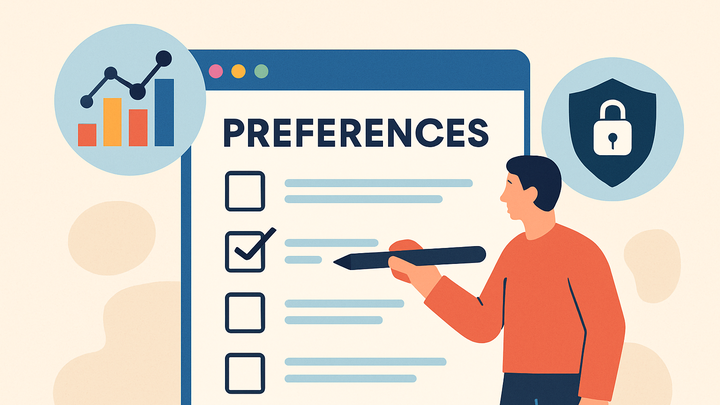Published on 2025-06-22T10:24:25Z
What is Zero-Party Data? Examples in Analytics
Zero-party data is information that customers intentionally and proactively share with a brand. Unlike first-party data (behavioral data collected by your site) or third-party data (collected by external entities), zero-party data consists of explicit preferences, purchase intentions, and feedback directly provided by the consumer.
In the analytics industry, zero-party data is valuable because it offers clear insights into customer intentions without relying on cookies or external trackers. When combined with behavioral analytics tools like GA4 or PlainSignal, it allows businesses to personalize user experiences, improve engagement, and maintain compliance with privacy regulations such as GDPR and CCPA.
Common methods for collecting zero-party data include surveys, quizzes, preference centers, and interactive forms. These methods not only gather insights but also empower customers by giving them control over the data they share.
Below are examples and best practices for implementing zero-party data strategies in analytics.
Zero-party data
Zero-party data is data customers intentionally share, such as preferences and feedback, used for personalized, privacy-conscious analytics.
Why Zero-Party Data Matters
Zero-party data provides direct insights into customer preferences and intentions, enabling brands to tailor experiences and build trust.
By relying on voluntarily shared information, companies can avoid privacy pitfalls associated with third-party cookies and meet regulatory standards.
-
Enhanced personalization
Because zero-party data is voluntarily shared by customers, it enables precise personalization of content and offerings.
-
Improved customer trust
Voluntary sharing fosters transparency and builds trust, as customers understand what information they’re providing and why.
-
Privacy and compliance
Collecting zero-party data with explicit consent aligns with privacy regulations like GDPR and CCPA, reducing legal risk.
Zero-Party Data vs. Other Data Types
Understanding how zero-party data differs from first-, second-, and third-party data clarifies its unique value and use cases.
-
First-party data
Data collected directly by your website or app, such as pageviews, clicks, and session duration tracked by GA4 or PlainSignal.
-
Example
Analyzing user navigation paths in GA4 to optimize site structure.
-
-
Second-party data
Another company’s first-party data acquired through partnerships or data sharing agreements.
-
Third-party data
Data collected by entities with no direct relationship to the customer, often aggregated from multiple sources.
-
Zero-party data
Data that customers proactively and explicitly share, such as preferences, interests, and feedback.
Collecting Zero-Party Data
Various methods enable the collection of zero-party data. Tools like GA4 and PlainSignal can complement these methods by tracking engagement.
-
Surveys and questionnaires
Online surveys ask targeted questions; integration with GA4 Events can help measure survey completion and engagement.
-
Preference centers
Self-service portals where customers set their communication and content preferences; data is stored in a CRM or CDP.
-
Interactive forms
Forms embedded in websites using HTML and JavaScript. Below are examples of integrating tracking for analytics:
-
PlainSignal tracking code
<link rel="preconnect" href="//eu.plainsignal.com/" crossorigin /> <script defer data-do="yourwebsitedomain.com" data-id="0GQV1xmtzQQ" data-api="//eu.plainsignal.com" src="//cdn.plainsignal.com/plainsignal-min.js"></script> -
GA4 setup
<!-- Google Tag (gtag.js) --> <script async src="https://www.googletagmanager.com/gtag/js?id=GA_MEASUREMENT_ID"></script> <script> window.dataLayer = window.dataLayer || []; function gtag(){dataLayer.push(arguments);} gtag('js', new Date()); gtag('config', 'GA_MEASUREMENT_ID'); </script>
-
Real-World Use Cases
Brands leverage zero-party data in various analytics-driven scenarios to deliver personalized experiences and measure success.
-
E-commerce personalization
Retailers ask customers about style and size preferences then track engagement with bespoke recommendations using GA4 events.
-
Content recommendations
Publishers collect topic interests via quizzes and then analyze reading behavior with PlainSignal to gauge content relevance.
Best Practices and Considerations
Ensure your zero-party data strategy is effective and compliant by following these best practices.
-
Transparency and consent
Clearly inform users why you collect data and how it will be used; obtain explicit opt-in.
-
Data minimization
Ask only for necessary information to reduce friction and increase completion rates.
-
Analytics integration
Combine zero-party data with behavioral analytics from GA4 or PlainSignal to enrich user profiles and reporting.
